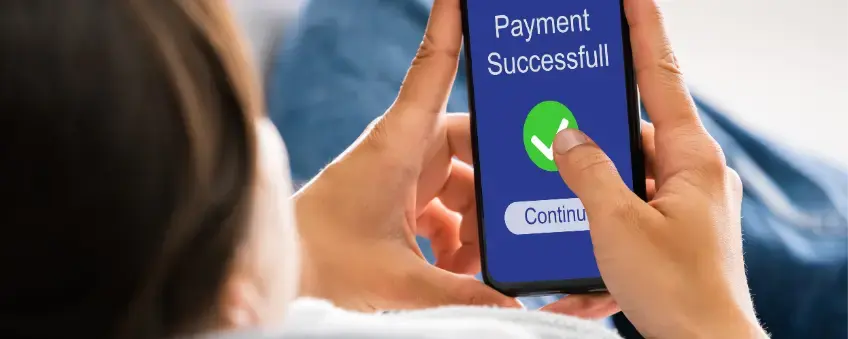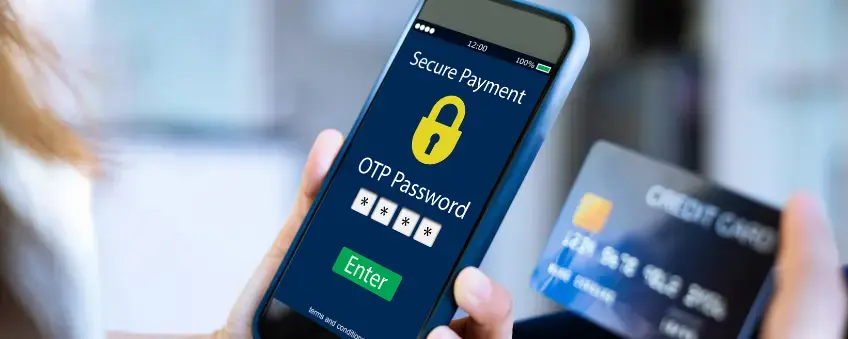Payment links create a seamless checkout experience for customers. Merchants can send payment links via digital invoices, emails, SMS messages, social media posts, or various other channels. Customers click the link and are transported to a payment gateway to complete the transaction. Sometimes, customers can pre-save credit card details to facilitate a one-click checkout process.
Consumers prefer credit cards due to their convenience. Payment links simplify the payment process, making it even easier to complete credit card transactions. In doing so, payment links help businesses increase conversion rates and decrease late payments. This guide explores payment links, their benefits, their disadvantages, how to set up new payment links for your business, and a range of related topics. Read ahead to learn more about one of the best-converting payment methods available to merchants!
Defining Link Payments
A payment link is a digital URL link that redirects customers to a secure payment gateway. Merchants can send payment links via email, invoice, SMS, social media posts, or various other communication methods. Payment links can be customized based on the transaction. Sometimes, they are customer-specific, with a pre-defined amount already set when the customer reaches the payment portal. In other instances, payment links allow customers to enter the amount they wish to pay or choose specific products or services. This versatility makes payment links a powerful tool for simplifying and streamlining the payment process.
What is a Link Payment, and How Do They Work?
So, what is a payment link? A payment link is a URL link that redirects customers to a secure payment gateway. Merchants can send payment links using SMS messages, emails, social media posts, advertising materials, QR codes, and more. Let's break down how payment links work step by step:
1. The customer receives a payment link
First, a merchant sends a customer a payment link via SMS, email, customer support chat, or any other communication channel. The link may be accompanied by text explaining its purpose, such as a message about paying an outstanding invoice.
2. The customer clicks the link
Next, the customer clicks the link and is redirected to a payment gateway. The gateway uses encryption to ensure a secure connection between the customer and the merchant's credit card processor.
3. The customer inputs credit card details to complete the payment
Once the payment gateway loads, the customer inputs their credit card details to complete the payment. This often includes billing information, such as customer name and billing address. In some cases, the payment gateway allows the customer to save payment details for future use, removing the need to re-enter details for repeat purchases.
4. The payment is transferred to the merchant and recorded internally
Lastly, the money from the transaction transfers to the business's merchant account. A record of the payment is recorded internally — and in most cases, the customer receives a receipt via text or email to confirm the payment.
What Type of Transaction is Recorded When a Customer Pays via a Payment Link?
When a customer pays using a payment link, it's treated similarly to any other type of credit card transaction: it's recorded as a sales receipt. A payment link doesn't have a separate function from a traditional credit card transaction. Customers click the link and are directed to a payment gateway to input their credit card details — it's similar to any online payment. There is no difference between payment links and traditional credit card transactions.
Link Payment Benefits
Payment links offer a variety of advantages to both merchants and customers. Let's explore the top benefits of this payment method below:
1. Payment convenience
First and foremost, payment links offer convenience to a merchant's customers. By sending a link directly connected to a payment gateway, merchants ensure their customers can complete payment in seconds. The customer does not need to log into an account, send money via an ACH transfer, or perform other time-consuming efforts to settle the transaction. Payment links are a customer-friendly tool.
2. Security
Over-the-phone and email payments require customers to disclose sensitive payment details to a staff member, creating security vulnerabilities. Many customers prefer the security of an encrypted payment gateway (available via a payment link).
3. Customization
Many payment link providers make it simple to customize the checkout process. Merchants can design the checkout portal to contain logos, custom branding, color schemes, and more. In doing so, merchants control the checkout experience from start to finish.
4. Pre-saved payment details
Some payment link platforms allow customers to save payment details for future use. In doing so, customers aren't required to re-enter card numbers or billing addresses, streamlining the transaction process. Research suggests that 62% of customers tend to abandon purchases if the payment process exceeds two minutes, so pre-saved payment details are a major asset to merchants.
5. Quicker payments
Ultimately, all the previously mentioned benefits lead to the primary advantage of using payment links: Quicker payments! As a business, ensuring all outstanding invoices are paid promptly is critical. Research suggests that invoices sent with digital payment links are paid three times faster on average. Streamlining the payment process with links enables businesses to benefit from improved cash flow and financial stability.
Disadvantages of Link Payments
While payment links offer a variety of benefits to merchants and customers, there are some downsides associated with this payment method:
1. Fraud exposure
As with any card-not-present transaction, payment links expose businesses to fraud. While payment links direct customers to encrypted payment gateways, which are more secure than over-the-phone and email payments, there are still vulnerabilities. Namely, as the customer does not need to present the physical card to complete the transaction, scammers can use payment links to input stolen credit card details. Hence, it's critical to use fraud prevention tools, such as two-factor authentication (2FA) and address verification, to spot scammers.
2. Higher processing fees
As card-not-present transactions are a higher risk for merchants and payment processors, they usually come at a higher price. Payment links typically carry higher credit card processing fees than in-person credit card transactions. Likewise, they are more expensive than traditional invoice payment options, such as ACH transfers.
3. Potential for impersonation
Criminals may spot an opportunity if your business routinely sends customers payment links. Scammers may send fraudulent payment links, impersonating your company and encouraging customers to complete payments. While this remains outside of a merchant's control, it still reflects poorly on their business if customers fall victim to scammers. It's critical to monitor for potential scams and warn customers if a third party attempts to impersonate your business.
Steps to Setting Up a Link Payment Page
If you're ready to harness the power of payment links, it's time to set up a payment link page for your business. Follow the steps below to get started with payment links:
1. Partner with a payment provider
First, you must find a payment provider with payment link capabilities. It's essential to work with a payment provider that can help you automate payment links. Automation is useful for billing customers and following up on late payments. Likewise, it's best to work with a payment provider that offers a full suite of payment options, not just payment links. Centralizing all your payment tools ensures that your reporting data stays in one place, simplifying the process of tracking income and other key metrics.
2. Set up a payment link
Next, it's time to set up a payment link. While this process will vary depending on the payment provider, you'll usually have the option to customize payment amount, payment limits, link expiry, and other details. For example, you can choose to generate a payment link that anyone can use to purchase a product or generate a customer-specific payment link to attach to an invoice.
3. Send it to your customer
Once you generate the link, it's time to send it to your customer. In the case of invoice payment links, this will involve inserting the payment link into your invoice before sending it to your customer. For other payment links, it's possible to send the link via SMS, email, customer support chats, social media posts, and more!
4. Track metrics and reconfigure the payment link
Likewise, the merchant can reconfigure the payment link at any time. This includes turning off the payment link, setting an expiry date on the payment link, or changing the types of payment methods accepted via the link.
How to Use Payment Links for Creative Marketing
Payment links provide a ripe opportunity for creative marketing. Links provide a subtle yet direct method for including payment details in marketing campaigns. Let's explore three examples of how payment links are valuable for creative marketing:
1. Include links in marketing materials
One way to use payment links for creative marketing is to include links in marketing materials. Whether it's brochures, billboards, emails, or any other marketing channel, a payment link makes it easy for a customer to purchase a product or service immediately.
2. Utilize links in social media campaigns
Payment links are extremely useful for social media campaigns. Whether you're uploading a post on Instagram, creating a video for a Facebook ad, or engaging in any other social media outreach, you can include payment links to simplify the conversion process.
3. Use QR code links at events
QR code links are a valuable tool for making it simple for customers to purchase products or services at events. For example, if your business sponsors a tent at a local event, you can print QR codes onto your promotional materials to make it easy for customers to complete purchases or make donations.
Creating Customer Friendly, Sharable Payment Links
As the primary goal of payment links is to provide convenience to your customers, making them as customer-friendly and sharable as possible is essential. Let's explore five methods merchants can use to improve customer experience with payment links:
Payment Links on Social Media Platforms
When people ask, "What is a payment link method?" they're often referring to embedded social media payment links. Many leading social media platforms, including Facebook and Instagram, now offer payment links for eCommerce brands selling products or services on their platforms. Payment links simplify converting platform users to customers. For example, Instagram offers a range of in-app payment link opportunities for merchants. Additionally, merchants can request payments using Instagram payment links in Instagram chats with customers. This is a great way to request direct payments if you're chatting to a customer about a product or service. Explore all the payment link opportunities available on your primary social media channels.
Using Payment Links in Emails and Text Messages
Payment links offer a convenient way to request payments through email by providing customers with a secure, one-click method to complete transactions. Instead of navigating multiple steps, customers can simply click the link and pay instantly. This streamlined approach is ideal for businesses managing remote billing or handling recurring payments.
Likewise, many businesses use SMS messages to send payment links. SMS payment links allow customers to pay for products or services quickly on their phones. It's easy to automate this process of sending invoice payment links, following up on late payments, and more.
Website and Blog Payment Links
Businesses can use payment links as effective calls-to-action (CTAs) on websites and blogs. By using payment links to facilitate a one-click payment process, you can remove the hassle of checking out on your website. Simply insert the link on product pages, blogs, or other areas where you want to convert web visitors into paying customers.
In-Person Selling Payment Links
Payment links aren't just for collecting payments from not-present customers; they're also useful for in-person selling. Whether you operate a restaurant, charity, market stall, or any other business requiring in-person customer interaction, payment links make conversions easier. QR codes are one of the most popular tools for in-person payments using payment links. By simply scanning a QR code with their phone, customers can instantly access the payment link, making it quick and easy to pay for products or services.
Customer Service Chat Payment Links
Payment links provide a unique opportunity to request customer payments in a customer service chat setting. If your business has customer support agents speaking with customers via a live chat service, transmitting a payment link offers customers a secure and convenient transaction option. Payment links eliminate the need for customers to share sensitive payment information directly with your staff.
Which Popular Payment Link Provider Best Fits Your Business
Many payment providers offer payment links to merchants. It's not just traditional payment processors with payment link capabilities; various invoicing software, social media platforms, and more now offer payment links. Let's explore three of the top payment link providers available to merchants:
Stripe
Stripe is one of the world's leading digital payment providers. It offers a broad range of payment link features, making it simple to send links with multiple payment method options to customers. Merchants can create and send a link with just a few clicks. It's simple to customize link features, such as branding, logos, and color schemes. Likewise, you can adjust payment features, such as permitting promo codes or allowing customers to adjust product quantities during checkout.
While many of Stripe's features require technical know-how, its payment links don't require any technical experience. It's simple to distribute Stripe links via email, SMS, social media, and other marketing channels.
Stripe payment link processing rates
Merchants using Stripe to send payment links will pay the following processing rates:
- 2.9% + 30¢ per transaction for standard credit card payments (domestic)
- 2.6% + 30¢ per transaction or standard "Instant Bank Payments"
Square
Square, another leading payment service provider in the United States, also makes it easy for merchants to generate and distribute payment links. Similarly to Stripe, Square payment links offer a range of payment options, including credit cards, Apple Pay, Google Pay, and more (even Afterpay). Merchants can use Square payment links to accept payments for eCommerce purchases, deposits, recurring subscriptions, and more.
Square also makes it simple to distribute your links across multiple channels. Merchants can embed links into website buy buttons, distribute links via email, or even transform links into QR codes to print on physical promotional materials. Square simplifies the process of reaching your customers wherever they are.
Square payment link processing rates
Merchants using Square to send payment links will pay the following processing rates:
- 3.3% + 30¢ per transaction for standard credit card payments
PayPal
When consumers think of PayPal payment links, they often picture the simple, personal links PayPal allows users to create, making it easy for friends and family to send money. However, PayPal also offers merchants access to payment links and buttons, simplifying checkout. Log into your PayPal Business account to generate a new link to access payment links and buttons. In terms of features, PayPal offers less payment link versatility than Square and Stripe.
PayPal payment link processing rates
PayPay payment links processing is much less clear, as it varies depending on the payment method and the reason for the payment. Check the PayPal fees on their site to see which processing rates apply to your payment link type.
Common Payment Link Cases and Examples
Below, let's explore detailed examples of payment link use cases:
Payment link included on a digital invoice
One of the most popular payment link applications involves digital invoices. While digital invoices revolutionized the way businesses invoice their customers, payment links have made the process even more convenient. Traditionally, invoices included payment instructions, such as bank details for ACH transfers or a phone number to complete an over-the-phone payment. With payment links, customers simply click the link and pay using a secure payment gateway, taking the hassle out of settling invoice balances.
Payment link for an overdue balance sent to a customer via SMS message
Businesses send payment links via SMS messages to request overdue payments. Instead of calling a customer to request a payment or sending an SMS with complex payment instructions, a payment link allows the customer to complete the payment in seconds. Many payment processors can automate this process, ensuring all overdue payments trigger a follow-up message with a payment link. This is an effective tool for settling outstanding balances.
Final Thoughts on Links Payments
With shoppers 63% more likely to shop at retailers offering their preferred payment method, it's critical to offer multi-channel payment options to customers. Payment links are a valuable tool for businesses to improve conversion rates and customer payment experience. Many of the world's leading payment providers make it easy for businesses to create and distribute payment links. Merchants without technical payment experience have no issue generating payment links for SMS, email, social media campaigns, and more.
It's critical to choose a trusted payment provider to ensure your business benefits from all the advantages offered by payment links. And while Stripe, Square, and other payment service providers offer convenient payment link solutions to their merchants, they come at a high price. By partnering with a merchant account provider with payment links, your business can benefit from more affordable payment processing fees, better account stability, and dedicated account managers!
Link Payment FAQ
Yes, payment links are secure. When a customer clicks a payment link, they are directed to a secure, encrypted payment gateway where they can input their credit card details to complete the transaction. However, as with any payment method, it's critical to employ best practices to avoid security issues. This includes partnering with a security-focused payment processor, complying with PCI DSS, using anti-fraud software, and promptly notifying customers of any suspicious activity related to their payment.
Yes, payment links support various payment methods. The methods supported will vary depending on your payment processor. Many payment links support credit card payments, ACH transfers, digital wallets (such as Apple Pay and Google Pay), and more. However, the methods supported will vary depending on your payment processor.
Yes, some payment links are reusable. It's possible to create both one-time and reusable payment links. One-time payment links are more appropriate if you want a customer to settle a specific balance, such as an invoice. On the other hand, if you're not invoicing for a custom service or product, a reusable payment link might be more suitable, as you won't need to set up multiple links to accept payments. For example, if a charity uses a QR code payment link on brochures to raise money, it's preferable if multiple donors can use the same link.
Yes, many payment processors enable merchants to customize payment links. By customizing a payment link, a merchant can design the checkout process to align with its branding. For example, a merchant may customize the payment gateway to include business logos, color schemes, and branding. Likewise, the merchant may customize the text associated with the payment link (this is particularly important for payment links sent via SMS).
An invoice is a document provided by a merchant to a buyer outlining the details of goods and services provided. Likewise, an invoice has various payment details, such as the amount due, contact information, payment due date, and more. It's a formal document for requesting payment from a buyer. On the other hand, a payment link is a digital link that redirects a buyer to a payment gateway, making it easy for customers to purchase goods and services. Many businesses now include digital payment links on their invoices to simplify settling customer balances. It's a valuable tool for speeding up payments.
There's no official limit to how many times a customer can make a payment via a payment link before it expires. Instead, the merchant can place limits or restrictions on payment links. If a merchant wants customers to be able to use the same payment link multiple times, they should avoid setting an expiry date for the link. Conversely, if they want to restrict usage, they can create one-time payment links or links with specific limits to control how often customers can make payments.
Whether a payment link expires depends on restrictions set by the merchant. Merchants can configure payment links to meet specific payment limits or expiry dates. For example, some payment links are one-time payment links — they expire after the customer completes a payment. On the other hand, some payment links permit unlimited payments, so they don't expire until the merchant turns the link off.






